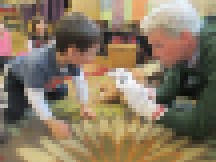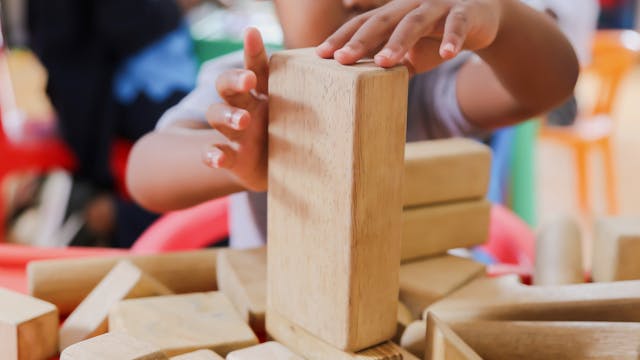Throughout my 20 years in the field of early childhood development, in the classroom and as a kids’ show host, I have observed that a young child in focused, self-guided, open-ended play is like a lucid dreamer. Consider how our subconscious processes the experiences of our daily lives during our dream cycles. When adults pay attention to children’s verbal and non-verbal play, we are, in a way, able to look into their subconscious, and with some careful observation and analysis, gain a pretty good idea about what they are experiencing in their daily lives. From there we can begin to figure out how we can best serve their specific needs.
I remember vividly the first time I saw this in action. I was a rookie preschool teacher working in Chicago. It was the morning of Sept. 12, 2001, the day after the attacks on the United States known as 9/11. We combined classrooms as our attendance was very low and the director of the school said that it would be best for the children if we allowed as much free play as possible that day. Beyond it being the children’s favorite activity, I didn’t fully understand why play would be so important on that particular day.
As my peers quietly compared updates on the chain of events happening in the adult world, the most experienced educator in the room, who the children called “Ms. Cathy,” was intensely watching the children play in the block corner. I took her cue and started to look too, but I didn’t see anything unusual for that area. They were building structures and knocking them down just like any other day. I asked Ms. Cathy what we were looking at. “Just watch and listen,” she said, and I did. It was quieter than usual. In fact, there was no talking at all. No tracks were being made for the cars to race on. No little ramps to jump. Just the repetition of building up structures and knocking them down. No laughing. No fighting. Just serious little faces building up structures and knocking them down again and again and again.
After a while, I watched Ms. Cathy carefully walk over to the group playing. She sat down next to one little boy, criss-cross-applesauce, as he was starting to build up the blocks again. She didn’t say a word. She was just with him. After he knocked his structure over again with his car, she gently put her hand on his back. The boy stopped and rested his head on her lap. She stroked his back, and from there, with some gentle prompts, she was able to talk with him about what he had seen the night before on TV.
I recently shared that story with Dr. Chip Donohue, founding director of the Technology in Early Childhood Center at Erikson Institute. He explained that, in a way, the events of 9/11 happened multiple times for young children at that period because of the ‘round-the-clock television news coverage and continuous replays of the tragedy, including the planes hitting the towers.
The language of play isn’t just for children. It can also be a tool for adults to process the complex, and it has served me over the years in my work with young children and as a parent.

At the height of quarantine, I found myself flashing back to Ms. Cathy and to all the moments since that day when I’ve used play as a tool to understand the inner-workings of a child. The pandemic has created heightened emotion for people of all ages, and it’s a critical time to be listening to our children and observing their play to learn more about their feelings.
I called my friend and colleague, Rachel Giannini, a thoughtful early childhood specialist featured in the documentary “No Small Matter,” to talk about the intersection of play and mental health. She shared that, in a way, COVID-19 and the resulting lockdown had given adults a reminder of what it can be like to be a child. Constantly waiting for adults to share what’s coming next, forced to adapt to changing routines that impact our emotional and physical well-being, dealing with constantly changing rules and desperately striving for independence and freedom, while at the same time wanting to rely on trusted touchstones during times of uncertainty.
Unstructured play can be difficult for parents, educators and caregivers to embrace for a number of reasons, especially during a period of time when social distancing and mask-wearing have become the norm.
On the surface, it can feel much more manageable to plan out activities with set goals and parameters, and of course that type of structure has value. But children also need and deserve the space to process the complexities of power on their own. Not the type of superficial power that comes from being big, strong and loud, but a deeper type of power that comes from the ability to problem-solve, self-regulate, empathize and negotiate with peers, learn from failure and ultimately to become active members of a shared community.
Imagine a child running with a stick. What is your first reaction? I’ve known many adults in that situation who have justifiably reacted in the moment with a, “Hey, kid! Put that thing down before you get hurt!” Or, “We don’t play that way here.” Many adults can only see one possible outcome, and it’s not a good one. But I’ve also known others in that same scenario who have said, “Hey! I see you found a stick. You can do so many different things with a stick. You can build with it, or draw in the mud, or pretend it's a magic wand. A stick can be anything you can imagine. And if you’re not careful, you could hurt yourself or someone else.” That same adult might offer some parameters for safety and a message that they are there for support as needed. After that, they might allow the space for the child to practice responsibility, to make mistakes and to learn from those mistakes along the way.
I talk a big game, but it took me a long time to embrace the second approach. It’s hard to let go. I often just want to shield my own children, my students and my viewers. I want to protect their innocence, but too often the harsh realities of life break through.
For example, many of the children that I have worked with over the years in Chicago and Baltimore have had first and secondary experiences with gun violence. In their violent dramatic play, sticks often become guns. Violent dramatic play doesn’t typically mean children are playing with the intention to hurt in real life. In my experience, violent dramatic play can be a way for children to express their fear, anger, anxiety and general curiosity about violent events they have witnessed in their lives. They can act out different players, beyond just “good” or “bad,” and try on different roles to gain a deeper understanding of perspective, motivation and reaction.
Empathy grows from the seeds of play. Fortunately, play is a natural human behavior. It doesn’t have to be taught, we just need to foster it.
Today, as I return to visiting classrooms in person to guide play-based social-emotional investigations as a specialist, I still see children playing with blocks. They’re still building structures and knocking them down, but they’re also using blocks as medicines to take care of their friends; as guns to explore the complexities of power; and as smartphones to share their thoughts, ideas and feelings. A family friend and mentor, David Newell, who played Mr. McFeely on “Mister Rogers’ Neighborhood,” once explained it to me like this: “It’s not that kids today have changed. It’s the world around them.”
I don’t know what is coming as we all head into 2022, but as a parent, early educator and creator of children’s media, I do know that I’m going to focus on striving to speak in the language of play as a means to process complex issues.
And whether it is exploring anxiety about COVID through block play, navigating the complexities of violence by role-playing with sticks, or reflecting their caregivers’ social media behaviors through their dramatic play, I’m going to try to remember that our children are often trying to tell us something not only about themselves, but also about us as well. We just need to listen and be ready to play.


